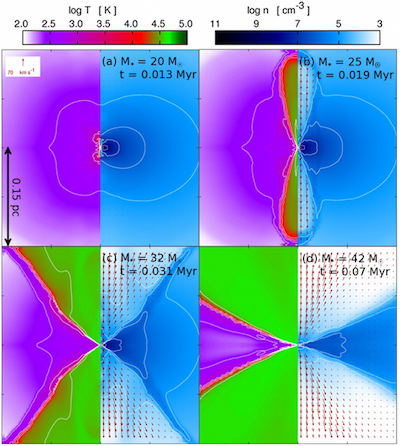- Title: The Evolution of Accretion in Young Stellar Objects: Strong Accretors at 3 – 10 MYR
- Authors: L. Ingleby, N. Calvet, J. Hernandez, et al.
- First Author’s Institution: University of Michigan
- Status: Accepted for publication by The Astrophysical Journal
Background
T Tauri stars are newly formed proto-stars which have yet to begin fusing hydrogen. These stars are often found very near to star-forming regions because they have not had time to drift away. They are surrounded by large protoplanetary accretion disks and are still accreting material and growing. T Tauri stars typically exist for about 100 million years (Myr) before they begin fusing hydrogen at their cores.
Previous observations of T Tauri stars have found that the accretion rate declines with age. Accretion rates have been observed as high as 10-4 solar masses per year for young T Tauri stars. Older T Tauri stars have been observed with accretion rates as low as 10-10 solar masses per year. There are a couple reasons why this happens. First, as material from the inner part of the disk accretes onto the star, the accretion disk is depleted in that region. If the disk does not evolve and move in to fill that region with more material, the accretion rate will drop. Alternatively, radiation from the newly-formed star could blow away the inner parts of the accretion disk, reducing the overall accretion rate. Once the accretion rate drops, astronomers refer to the systems as weak T Tauri stars. Classical T Tauri stars are those with higher accretion rates.
A few T Tauri stars have been found with high accretion rates up to 10 Myr, well after the accretion rate typically drops. Since not many of these systems have been observed, it is unclear whether they are anomalous or represent a different evolutionary path. In this paper, the authors look at eight T Tauri stars to measure their ages and mass accretion rates. They find seven systems which have accretion rates higher than would be expected.
Observations and Analysis
Observations were made of stars in three different star forming regions. UV and optical data show how the spectral energy distribution changed. For the older systems, it is expected that the accretion rate should have dropped and thus should show spectra of weak T Tauri stars. Observations of known weak T Tauri stars, combined with computed theoretical models, show the flux which these systems emit. The same is true for T Tauri stars which are still accreting. The authors compared their spectra to templates created for both types, shown in Figure 1.

Figure 1: Accretion templates fit to the spectra of eight T Tauri stars. Dashed and dotted lines represent different accretion rate columns. The red line represents the sum of the different rates. The Balmer Jump is responsible for the discontinuity at 3646 Angstroms. The model the authors used does not attempt to fit the emission lines.
Material that is falling onto the photosphere of the star will form an accretion shock which radiates brightly in the UV and X-ray portion of the spectrum. The nearest part of the accretion disk will reprocess this radiation, emitting it in at UV and blue optical wavelengths. So this portion of the spectrum is used to measure the overall accretion rate. The authors then used models to fit the spectra that depend on the energy distribution of individual accretion columns. This distribution depends upon whether radiation is coming from the accretion shock or the reprocessed inner edge of the accretion disk.
The total accretion rate is given by summing the contribution from each accretion column. In Figure 1, the dashed and dotted lines represent the contribution from individual columns. The red line shows the sum of the final summed accretion model. In these spectra, templates of weakly accreting T Tauri stars have been subtracted, leaving only radiation emitted from accretion.
After fitting these spectra, the authors found the total accretion rates were higher than would be expected for systems of these ages. A number of the systems were around 10-8 or 10-9 solar masses per year. While still lower than the accretion rate for a new T Tauri star, this amount is one or two orders of magnitude higher than expected based on the age of these clusters.
Results
The authors finally tried to explain why the accretion rate in some systems would remain higher than in others. They first tried a model in which the accretion disk would evolve with time and thus lead to varying accretion rates at a particular age. However, they were unable to create a model which did not require an initial accretion disk so massive it was gravitationally unstable. These higher accretion rates could also be a short-lived phase of higher than normal accretion. Work is needed to find more of these systems to show they are common, and to understand what causes their accretion rates to remain so high.





Hi Josh, very interesting article! If with these current models, high accretion rates cannot be explained while keeping the accretion disks gravitationally stable, what else could be going on? Are there any hypotheses as to what the mechanism could be?